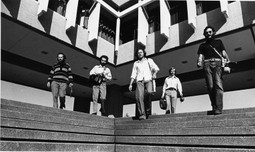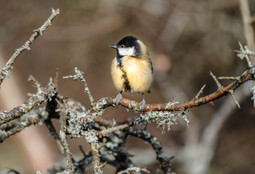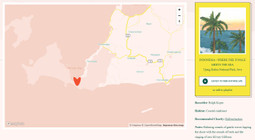
Soundscape and acoustic ecology: The music of a changing world
Learning to simply listen can sometimes profoundly impact our lives and how we interact with the world. Understanding the acoustic environment around us can be crucial; this is what soundscape ecology is all about.
As I write, I am listening to the sounds around me: the wind rustling the spring leaves outside my window, open to let in the fresh spring air; birdsong; the rattle of a woodpecker in the woodland beyond the garden; the drone of a busy bee. But there are other sounds, too: the low hum of my laptop, the tapping as I type, and the dull roar and rumble of cars passing on the road.
In this article, we will delve into this topic, exploring the history of soundscape ecology and how the sounds we make – and those around us – give a unique insight into both natural ecology and ourselves, and shape the music of a changing world.
What is Soundscape Ecology?
Simply put, soundscape ecology is the study of sound and of how sounds of different origins shape the world around them. It is about how life on our planet, including our own, is shaped by its auditory environment.
Soundscape ecology contains different areas of focus, but the key goals are always to better understand how noises interact and the impacts of those interactions. Increasingly, there is an understanding of the importance of soundscapes, and a drive to preserve or alter them for the better.
This field has been defined as the study of all “biological, geophysical, and anthropogenic sounds that emanate from a landscape and which vary over space and time[,] reflecting important ecosystem processes and human activities.”
The Three Sources of Sound
A soundscape is an acoustic environment; soundscapes are made up of three different sources of sound:
Sounds from all three sources make up the soundscape of a particular place and time.
Geophony
From the Greek ‘geo’ (Earth) and ‘phon’ (sound)
Geophony describes sounds created not by living creatures, but by the natural environment. This includes, for example, the sounds of water, wind, thunder, and all other non-biological noises of the natural world.
Biophony
‘Bio’ (life) and ‘phon’ (sound)
Biophony is all the noises made by living organisms in a given habitat at a given time (except for human beings).
Anthropophony
‘Anthropo’ (human) and ‘phon’ (sound)
Anthropophony refers to all human-made noise. This includes noises made directly by humans themselves and by our technological, electrical, or mechanical devices.
This category is divided into two sub-categories: controlled sound, such as language, music, and theater, and chaotic or incoherent sound, sometimes referred to as ‘noise’.
Soundscape Features
Soundscapes, and the way we perceive them, have been broken into three categories:
- Keynote sounds: the background tones of an environment that are directly influenced by geography and climate, including those made by wind, water, animals, vegetation, and geological features. These sounds are not listened to consciously, but may deeply imprint on a person’s sense of place
- Sound signals: in contrast to keynotes, these are listened to consciously, since they typically convey information or warnings (eg, train whistles, car horns, or ambulance sirens)
- Soundmarks: sounds which, like landmarks, are unique to specific locations.
The History of Soundscape Ecology

Soundscape ecology builds on the work of Bernie Krause and Stuart Gage, who coined the terms used for the three sources of sound outlined above.
They in turn built on the work of R. Murray Schafer and Barry Truax, whose work in acoustic ecology focuses primarily on the human perception of soundscapes. It was Schafer who categorized the soundscape features mentioned above. He credits the coining of ‘soundscape’ to city planner Michael Southworth, who led a project in Boston in the 1960s and reported his findings in his paper ‘The Sonic Environment of Cities’ (1969).
In the 1960s and early 1970s, the World Soundscape Project was established at Simon Fraser University as an educational and research group. They worked to record The Vancouver Soundscape, and went on to document the soundscapes of Canada, and, subsequently, Five Village Soundscapes in Europe. The original project culminated in the publication of the Handbook for Acoustic Ecology (1978).

Photo credit: The World Soundscape Project
In 1993, the World Forum for Acoustic Ecology was founded. This body brings together a multi-disciplinary spectrum of individuals engaged in the study of the social, cultural, and ecological aspects of sonic environments across the world.
Soundscape ecology is closely related to acoustic ecology, yet it seeks a broader perspective, one which considers not only the effects of soundscapes on people, but also on other living organisms, and potential interactions between sounds in a given environment.
Soundscape ecology was first described as an independent academic discipline in 2011; this was formalised at the first meeting of the International Society of Ecoacoustics, in Paris in 2014. However, this formalisation simply brought together considerable existing work and earlier investigations which incorporated elements of soundscape ecology theory.
Defining Soundscapes
By studying the impacts of the three sources of sound in the soundscapes around us, we can begin to define our world in new ways. We can learn about the sounds around us, and how they combine, shape environments, and become pivotal to particular times and places for people and for other forms of life.
Over the past decade or so, research within soundscape ecology has focused on measurement and interaction between the different sources of sound, their impacts on one another, and the impact of soundscapes on humans and on ecosystems.
The Impacts of Geophony
Pervasive geophonic sounds in an environment have been shown to influence other sound sources in several different ways. They also impact living organisms’ behavior and emotional states.
The acoustic adaptation hypothesis proposes that animals alter their signals according to different physical environments, in order to maximize their audibility.
Landforms (eg, valleys, rivers) cause various geophysical motion patterns, especially in relation to elements like water and wind, which cause repetitive sounds.
Evidence supports the effect of geophony on the sonic behavior of both marine and terrestrial animal vocalizations, and species’ evolution. Organisms alter their vocalization frequencies in order to avoid overlap with pervasive geophonic sounds in an environment. An example is that territorial communication in some frog species takes place in the ultrasonic spectrum, an evolutionary adaptation believed to be due to the low-frequency sound of constant running water in their environment. Geophony also has a role in mate selection in the little torrent frog.
As described in Mullet et al.’s ‘Acoustic Habitat Hypothesis’, it also seems that geophony plays a key role in determining the habitats animals choose to inhabit within a landscape.
In addition, just as geophony can impact biophony and the behavior of wildlife, so too can it influence people.
Confusingly, current academic literature characterizes geophony as having both positive and negative acoustic qualities, in the form of “natural quiet” and “environmental noise”, respectively.
Persistent, loud geophony – such as strong winds or crashing waves – may mask other elements of a soundscape and be perceived as ‘noise’. However, humans display a clear preference for biophony and geophony and an aversion to anthropophony. In parks and protected areas, preserving these elements of a soundscape improves visitor experiences.
Eliminating sources of anthropophony and finding natural ‘quiet’ (very much a subjective term), where geophony and biophony prevail, can help people feel calmer and more at peace. Many report positive feelings within such a landscape and positive associations with sounds such as, for example, running water or waves on a shore.
While we may tend to think of geophony as ‘background noise’, it has an important impact on the soundscapes around us and the natural music of our world.
The Impacts of Biophony
Noises made by living creatures in environments are often the defining elements of a natural soundscape. These sounds themselves may impact the vocalizations of other creatures within the same environment, and have a profound impact on how humans feel and behave.
The Niche Hypothesis suggests that acoustic signals in an environment will display frequency partitioning, as a result of selection acting to maximize the effectiveness of different species’ intraspecific communication.
And evidence suggests that animal sounds are indeed influenced by other vocalizations; each species evolves to establish and maintain its own acoustic niche so that its vocalizations are not masked by other biophony within the ecosystem.

As well as frequency being altered due to biophony, vocalizations may also be specifically timed in order to avoid too much acoustic overlap temporally, as well as spatially. For example, birds will chorus heavily at dawn and dusk, while frogs and toads call mostly during the night.
The impacts of biophony on humans are also widely documented. We seem to innately understand and respond to the natural richness of a soundscape – recognising the difference between one that is healthy and one that is not. The density, diversity, and richness of animal components of a soundscape are a way to measure species density and change within an ecosystem. Therefore, hearing birdsong and the other biophony within a soundscape can help us to feel calm and at peace, while we feel unease in an environment where these sounds are missing or drowned out.
The Impacts of Anthropophony
Geophony and biophony have defined Earth’s soundscapes for millennia. But, more and more, human-made sounds are encroaching on these sound sources, and having a profound and often hugely negative impact.
Much work has gone into defining the impact of anthropophony on wildlife, and on people. In particular, scientists have studied the impact of uncontrolled anthropophony (also known as noise pollution) on ecological systems and human well-being.
Noise pollution comes from a wide range of sources, including transportation networks and traffic, industry, and technology. Though often of particular concern in urban environments, it can also represent a major disturbance even in seemingly remote regions, such as national parks.
The impacts of chronic noise exposure on terrestrial and marine organisms has been well documented. These impacts are broad-ranging and disastrous, impacting a huge range of different creatures in worrying and profound ways.
Anthropophony often masks organisms’ acoustic signals, limiting their ability to communicate and depressing a range of ecological functions. This can interfere with biophonic processes and lead to physiological changes: increasing stress hormones, impairing cognition, reducing immune function, and even inducing damage to DNA.
Many studies have focused on the impact of anthropophony on bird species, which may be particularly sensitive to noise pollution since they rely on acoustic signals for intraspecific communication.
Many birds alter their songs in noisy environments; an example is great tits, which have been shown to use higher frequency sounds in their songs when living in noisy environments. Subsequent studies also showed that, in noisy urban environments, birds use shorter songs but repeat them more rapidly.

Birds may also simply sing more loudly in noisy environments, according to the Lombard Effect: the tendency of speakers to involuntarily increase their vocal effort when speaking in loud noise. Due to noise pollution in a soundscape, this reflex has been noted in birds, whales, monkeys, and many other animals, as well as in humans.
However, not all creatures change their songs in noisy environments, and some may be unable to do so. These non-adapting species may be particularly vulnerable to the habitat degradation that arises from noise pollution. Biodiversity is frequently reduced by increased anthropophony, with these areas hosting fewer species than those where natural soundscapes have been maintained.
As well as profoundly impacting the natural soundscape and ecology of an area, noise pollution also massively impacts human health and well-being.
The Lessons of Soundscape Ecology
By investigating the impacts on and interactions between different elements in soundscapes, we can begin to shape a better understanding of the environments around us.
It is increasingly clear that this field of study can provide a range of important insights helping us to understand our world, and how it is changing. Looking at particular soundscapes allows us to delve deeper and develop a more evolved and thorough understanding of both natural and human systems.
Some government agencies have adopted policies that recognise the teachings of soundscape ecology and recognized that sounds should be managed:
- In 2002, the European Commission adopted a directive on the assessment and management of noise. Policy objectives include assessing urban noise conditions, as well as those in ‘‘open country’’ or other noise-sensitive areas, in order to preserve quiet areas
- The US National Park Service (NPS) identifies soundscapes as a resource and considers all natural sounds within parks, and their interactions, to be part of the natural soundscape; its Natural Sounds and Night Skies Division works to protect them.
Documenting Soundscapes
With recording devices and various audio technologies, scientists and soundscape ecologists are able to undertake in-depth analysis of soundscape structure – collecting ecological data and establishing key findings in this field.
Interdisciplinary approaches to data acquisition have enabled a range of research projects into some of the impacts mentioned above, as well as helping collection of ‘big data’ and the conservation of acoustic diversity and natural soundscapes.
It is crucial to document the soundscapes of our planet – particularly those which offer a snapshot of a particular place and time, and those that are at risk. Recognizing the amazing richness of our auditory world, learning through listening, and taking steps to preserve what we have, is vitally important.
The documentation and monitoring of soundscapes is not only an area for scientists. This is something in which many of us can become involved. By taking time to record the sounds around us in our daily lives, and really stopping to listen, we can gain a deeper understanding of the world around us, and of ourselves.
In order to better understand soundscapes and soundscape ecology, we can also seek out recordings. For example, we can listen to sounds from US national parks here. And, of course, you can listen to sounds of nature from around the world right here on earth.fm.

Value in Soundscapes and Soundscape Conservation
There is a growing understanding that soundscape conservation is just as crucial as other kinds in combating the global environmental crises we face. Soundscapes possess both ecological and social value, and are therefore natural resources as worthy of management and conservation as other elements of our world.
Preserving the natural sounds of a particular place may be as challenging as conserving the mosaic of plants and animals that keep an ecosystem intact. So it is important that we recognise the value of doing so, and learn how we can successfully conserve soundscapes in the natural world.
Soundscapes give people a sense of place, and have cultural significance and a sense of community, as well as helping us feel calmer and more connected to the natural world and shaping our interactions with the natural features of our environment.
The impacts of soundscapes are felt not only by humans but by other animals too. Ecosystems’ complex webs of phonics are crucial indicators of their well-being, while wildlife depends upon the preservation of a natural soundscape, as the impacts of sound above have shown.
Author, environmentalist, and advocate for wilderness, Sigurd Olson, once wrote:
“Far more important than the places I have seen or what I have done or thought about is the possibility of hearing the singing wilderness and catching, perhaps, its real meaning.”
With the loss of habitat and biodiversity, areas lose their natural sounds. As the ability to experience natural sounds becomes increasingly rare, they have been referred to as an endangered resource – particularly as anthropophony continues to alter our planet’s natural soundscapes.
A Framework for Soundscape Conservation
Drawing on landscape ecology and conservation biology, it is possible to develop a framework for soundscape conservation. Many conservation biologists recognize that several key elements are needed to protect and preserve biodiversity:
- Identification of the target for conservation
- Establishment of key management goals that are measurable and responsive to policy actions
- A long term and constantly reviewed assessment of current areas. The SWOC analysis of strengths, weaknesses, opportunities, and challenges is a common approach
- Monitoring programs that ensure goals are being met, and to see where policy adjustments are required.
In this document, eight key types of soundscape are highlighted for conservation, due to their ecological or social value:
- Natural quiet soundscapes
- Sensitive soundscapes
- Threatened soundscapes
- Unique soundscapes
- Recreational soundscapes
- Representative soundscapes
- Cultural soundscapes
- Everyday soundscapes.
Though these are suggested as priorities for conservation, more work is required to identify and put into operation consensus frameworks for conservation of this type.
Soundscapes in Human Environments: Designing Acoustic Space
A key lesson from listening to the world around us is how to move from monitoring and documenting soundscapes to designing acoustic spaces within our built environments which work for people. Studying soundscapes is not only about their broader value; it also involves considering the listener and how they feel and behave.
There is an increasing understanding that developing sustainable living environments, and the sustainable cities of the future, means taking note of issues surrounding noise pollution, and designing spaces with soundscapes maintained to meet human and non-human needs alike.
Reducing sources of anthropophony is a pressing concern in relation to planning and developing urban environments, and to the broader ecosystems of our planet; the understanding that noise pollution can be as damaging to our environments as other forms of pollution is growing.
By delving deeper into soundscapes and their composition, we can also use our findings to create better and more functional living spaces.
The world is urbanizing rapidly. More than half of the global population now lives in cities. Benefitting the well-being of the increasing numbers of urban citizens by improving urban environments is becoming one of the most important challenges of the 21st century.
Although city planners customarily have visions of a ‘good urban environment’, those visions are usually limited to visual aesthetics. The qualitative perspective of sound – including sonic diversity and acoustic ecology – is an area often neglected within urban design.
Urban planning and design often seeks to control noises by reducing their decibel levels – for example, through land-use planning that keeps residential development out of noisy areas, and noise-minimizing structural design (windows, building materials, interior room layout).
Each city or town has its own unique and distinct phonic environment – which must be taken into account when designing an urban soundscape.
As Kraus argues, “An information rich, balanced soundscape contributes to the sense of an acoustic community, one where sound plays a formative role in the definition and life of a group of people, no matter how their commonality is defined.
“The ‘enemy’ of the acoustic community is not so much noise per se, but rather any element that lessens the clarity and definition of an acoustic space, or dulls people’s inclination to listen. In other words, the acoustic community depends on information exchange, and anything or any habit that detracts from or inhibits that exchange weakens the sense of community.”
The field of soundscape composition shows the impacts of altering human soundscapes to enable the auditory environment to better meet human needs, and to instil in the listener a certain feeling and series of complex associations.
Biophilia
Biophilia is a hypothetical human tendency or desire to commune with nature, and to feel a close connection to other forms of life in the natural world. Many feel that we are strongly drawn to nature, feeling a compulsion to be around it. This is borne out in studies which have shown people’s positive associations with spending time in natural environments.

When we talk about biophilia, we focus on seeing nature around us. But biophilia is very much a multi-sensory experience; as human beings, we are also drawn to smelling, touching, and hearing the natural world.
Biophilia may go some way towards explaining the sense of calm and peace we get from being surrounded by – or hearing – truly natural soundscapes, unpolluted by persistent anthropophony. This strong craving so many of us feel to be surrounded by natural sounds must be taken into account when we think about creating and maintaining soundscapes in human environments.
As climate change, biodiversity losses, and human pressures change our planet, the way it sounds also changes. By studying the soundscapes around us, and taking steps to conserve those with ecological and social value, we can help to minimize negative impacts on the sounds around us, and learn to harmonize with each other, and with the natural world.
We can learn lessons to help us build a better future, and come to a deeper understanding of the music and melodies of a changing world.
Earth.fm is a completely free streaming service of 1000+ nature sounds from around the world, offering natural soundscapes and guided meditations for people who wish to listen to nature, relax, and become more connected. Launched in 2022, Earth.fm is a non-profit and a 1% for the Planet Environmental Partner.
Check out our recordings of nature ambience from sound recordists and artists spanning the globe, our thematic playlists of immersive soundscapes and our Wind Is the Original Radio podcast.
You can join the Earth.fm family by signing up for our newsletter of weekly inspiration for your precious ears, or become a member to enjoy the extra Earth.fm features and goodies and support us on our mission.
Subscription fees contribute to growing our library of authentic nature sounds, research into topics like noise pollution and the connection between nature and mental wellbeing, as well as funding grants that support emerging nature sound recordists from underprivileged communities.
